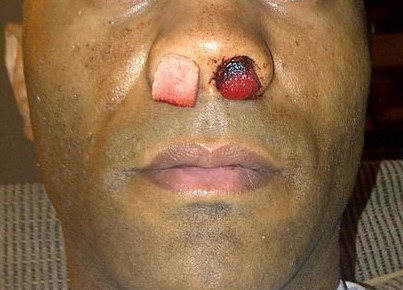For greater detail see: Nose Bleed Management and Epistaxis Control
Return to: Otolaryngology Medical Student Clerkship Objectives and Exam Topics (University of Iowa)
See also: Nosebleed - Epistaxis: Anterior Ethmoid Artery Ligation (External - Open Approach)
Nosebleed - Epistaxis: Sphenopalatine Artery (SPA) Ligation - Endoscopic
Overview
- Epistaxis, or nosebleeds: common problem that most people have dealt with at some point in their life
- Though most people don't seek medical attention, severe epistaxis can have complications
- More common in winter months
- Caused by trauma or irritation
- Children- digital trauma or other foreign object insertion
- Mucosal dryness
- Chronic intranasal drug use (cocaine, steroids)
- Neoplasm
- Anticoagulation (warfarin therapy)
- Nasal cannula

By TonyTheTiger (Own work) [CC BY-SA 3.0 (http://creativecommons.org/licenses/by-sa/3.0) or GFDL (http://www.gnu.org/copyleft/fdl.html)], via Wikimedia Commons
Anatomy
- Anterior bleeds (90%)
- Majority of episodes are from the anterior septum
- Kiesselbach's plexus, anastomosis of:
- Septal branch of anterior ethmoidal artery (ophthalmic artery)
- Lateral nasal branch of sphenopalatine artery (maxillary artery)
- Septal branch of superior labial artery (facial artery)
- Posterior bleeds (10%)
- Woodruff's plexus:
- Confluence of vessels posterior to the middle turbinate
- Formed from contributions of the:
- Sphenopalatine (from maxillary artery)
- Ascending pharyngeal (from external carotid)
- Internal maxillary veins
- Woodruff's plexus:
Evaluation
- Severity of bleed
- Ensure airway is secured and breathing is adequate
- Evaluate hemodynamics if a large volume of blood loss is suspected
- Underlying causes
- Local
- Trauma
- Foreign body
- Infection
- Dryness
- Benign Neoplasm
- Severe, unilateral, recurrent bleeds in young male raises concern for Juvenile Nasopharyngeal Angiofibroma
- Systemic
- Chronic disease conditions
- Hypertension
- Cancer
- Hereditary hemorrhagic telangiectasia (Osler-Weber-Rendu Syndrome)
- Medications
- Coagulopathy
- Chronic disease conditions
- Local
- Anterior vs Posterior bleed
- Important for management
- Treatment with a vasoconstrictive and anesthetic agent can aid in visualization
- Nasal endoscope can be helpful
- Posterior bleed in an adolescent male
- Consider nasopharyngeal angiofibroma
- Otolaryngology consult is required for possible surgical intervention
Management
- Anterior bleeds
- Direct pressure for 10-15 minutes will often resolve mild cases
- Sit patient forward so blood does not drain into nasopharynx
- Ingested blood can cause nausea and vomiting
- Ingestion of blood prevents accurate estimation of blood loss as it cannot be visualized
- Topical vascoconstriction- pledgets soaked with oxymetazoline may be used
- Cautery- silver nitrate sticks
- Nasal packing
- 3-5 days
- Types
- Nasal tampons (eg. Rhino Rocket)
- Gauze
- Balloon catheters
- Some hospitalize if bilateral packing is used due to concern for airway obstruction
- Prophylactic antibiotics can be considered due to concern for development of toxic shock syndrome (TSS)
- Posterior bleeds
- More difficult to manage
- Hospitalization is recommended for most posterior bleeds as they are more difficult to control
- Nasal packing
- Balloon catheter
- Cotton packing
- Consider antibiotics
- Surgical Management
- Arterial ligation
- Endoscopic cautery
- Angiographic embolization by Interventional Radiology
- Tumor removal if present (eg. angiofibroma)
References
American Academy of Otolaryngology–Head and Neck Surgery Foundation. (2011). Primary Care Otolaryngology, Third Edition. Retrieved from: www.entnet.org.
Alter, H. Approach to the adult with epistaxis. In: UpToDate, Grayzel, J. (Ed), UpToDate, Waltham, MA. (Accessed on June 10, 2015.)